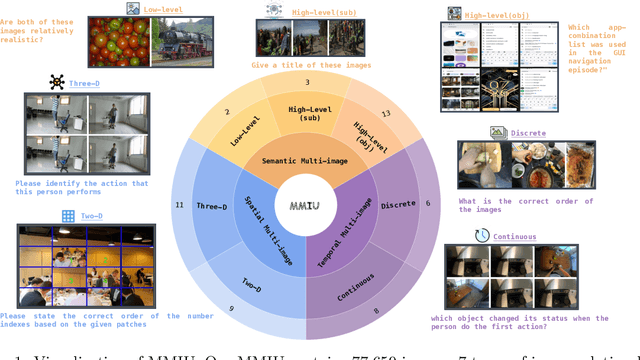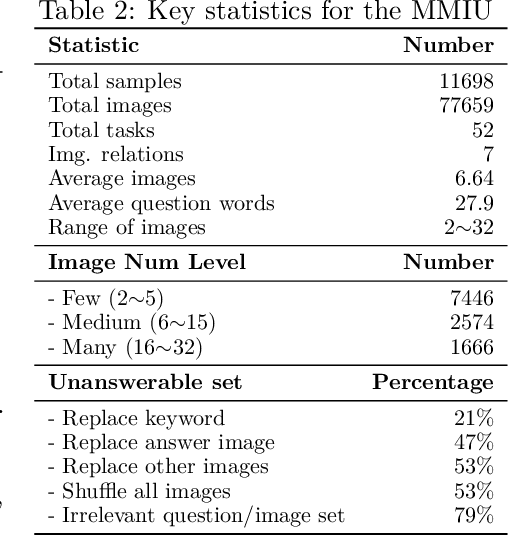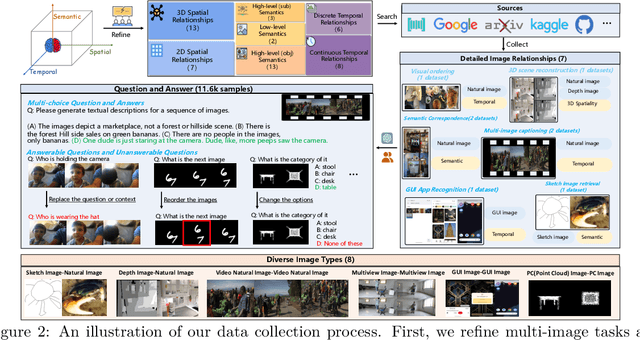Fanqing Meng
VideoREPA: Learning Physics for Video Generation through Relational Alignment with Foundation Models
May 29, 2025Abstract:Recent advancements in text-to-video (T2V) diffusion models have enabled high-fidelity and realistic video synthesis. However, current T2V models often struggle to generate physically plausible content due to their limited inherent ability to accurately understand physics. We found that while the representations within T2V models possess some capacity for physics understanding, they lag significantly behind those from recent video self-supervised learning methods. To this end, we propose a novel framework called VideoREPA, which distills physics understanding capability from video understanding foundation models into T2V models by aligning token-level relations. This closes the physics understanding gap and enable more physics-plausible generation. Specifically, we introduce the Token Relation Distillation (TRD) loss, leveraging spatio-temporal alignment to provide soft guidance suitable for finetuning powerful pre-trained T2V models, a critical departure from prior representation alignment (REPA) methods. To our knowledge, VideoREPA is the first REPA method designed for finetuning T2V models and specifically for injecting physical knowledge. Empirical evaluations show that VideoREPA substantially enhances the physics commonsense of baseline method, CogVideoX, achieving significant improvement on relevant benchmarks and demonstrating a strong capacity for generating videos consistent with intuitive physics. More video results are available at https://videorepa.github.io/.
MM-PRM: Enhancing Multimodal Mathematical Reasoning with Scalable Step-Level Supervision
May 19, 2025Abstract:While Multimodal Large Language Models (MLLMs) have achieved impressive progress in vision-language understanding, they still struggle with complex multi-step reasoning, often producing logically inconsistent or partially correct solutions. A key limitation lies in the lack of fine-grained supervision over intermediate reasoning steps. To address this, we propose MM-PRM, a process reward model trained within a fully automated, scalable framework. We first build MM-Policy, a strong multimodal model trained on diverse mathematical reasoning data. Then, we construct MM-K12, a curated dataset of 10,000 multimodal math problems with verifiable answers, which serves as seed data. Leveraging a Monte Carlo Tree Search (MCTS)-based pipeline, we generate over 700k step-level annotations without human labeling. The resulting PRM is used to score candidate reasoning paths in the Best-of-N inference setup and achieves significant improvements across both in-domain (MM-K12 test set) and out-of-domain (OlympiadBench, MathVista, etc.) benchmarks. Further analysis confirms the effectiveness of soft labels, smaller learning rates, and path diversity in optimizing PRM performance. MM-PRM demonstrates that process supervision is a powerful tool for enhancing the logical robustness of multimodal reasoning systems. We release all our codes and data at https://github.com/ModalMinds/MM-PRM.
CPGD: Toward Stable Rule-based Reinforcement Learning for Language Models
May 18, 2025Abstract:Recent advances in rule-based reinforcement learning (RL) have significantly improved the reasoning capability of language models (LMs) with rule-based rewards. However, existing RL methods -- such as GRPO, REINFORCE++, and RLOO -- often suffer from training instability, where large policy updates and improper clipping can lead to training collapse. To address this issue, we propose Clipped Policy Gradient Optimization with Policy Drift (CPGD), a novel algorithm designed to stabilize policy learning in LMs. CPGD introduces a policy drift constraint based on KL divergence to dynamically regularize policy updates, and leverages a clip mechanism on the logarithm of the ratio to prevent excessive policy updates. We provide theoretical justification for CPGD and demonstrate through empirical analysis that it mitigates the instability observed in prior approaches. Furthermore, we show that CPGD significantly improves performance while maintaining training stability. Our implementation balances theoretical rigor with practical usability, offering a robust alternative for RL in the post-training of LMs. We release our code at https://github.com/ModalMinds/MM-EUREKA.
LangBridge: Interpreting Image as a Combination of Language Embeddings
Mar 26, 2025Abstract:Recent years have witnessed remarkable advances in Large Vision-Language Models (LVLMs), which have achieved human-level performance across various complex vision-language tasks. Following LLaVA's paradigm, mainstream LVLMs typically employ a shallow MLP for visual-language alignment through a two-stage training process: pretraining for cross-modal alignment followed by instruction tuning. While this approach has proven effective, the underlying mechanisms of how MLPs bridge the modality gap remain poorly understood. Although some research has explored how LLMs process transformed visual tokens, few studies have investigated the fundamental alignment mechanism. Furthermore, the MLP adapter requires retraining whenever switching LLM backbones. To address these limitations, we first investigate the working principles of MLP adapters and discover that they learn to project visual embeddings into subspaces spanned by corresponding text embeddings progressively. Based on this insight, we propose LangBridge, a novel adapter that explicitly maps visual tokens to linear combinations of LLM vocabulary embeddings. This innovative design enables pretraining-free adapter transfer across different LLMs while maintaining performance. Our experimental results demonstrate that a LangBridge adapter pre-trained on Qwen2-0.5B can be directly applied to larger models such as LLaMA3-8B or Qwen2.5-14B while maintaining competitive performance. Overall, LangBridge enables interpretable vision-language alignment by grounding visual representations in LLM vocab embedding, while its plug-and-play design ensures efficient reuse across multiple LLMs with nearly no performance degradation. See our project page at https://jiaqiliao77.github.io/LangBridge.github.io/
MM-Eureka: Exploring Visual Aha Moment with Rule-based Large-scale Reinforcement Learning
Mar 10, 2025Abstract:We present MM-Eureka, a multimodal reasoning model that successfully extends large-scale rule-based reinforcement learning (RL) to multimodal reasoning. While rule-based RL has shown remarkable success in improving LLMs' reasoning abilities in text domains, its application to multimodal settings has remained challenging. Our work reproduces key characteristics of text-based RL systems like DeepSeek-R1 in the multimodal space, including steady increases in accuracy reward and response length, and the emergence of reflection behaviors. We demonstrate that both instruction-tuned and pre-trained models can develop strong multimodal reasoning capabilities through rule-based RL without supervised fine-tuning, showing superior data efficiency compared to alternative approaches. We open-source our complete pipeline to foster further research in this area. We release all our codes, models, data, etc. at https://github.com/ModalMinds/MM-EUREKA
Towards World Simulator: Crafting Physical Commonsense-Based Benchmark for Video Generation
Oct 07, 2024Abstract:Text-to-video (T2V) models like Sora have made significant strides in visualizing complex prompts, which is increasingly viewed as a promising path towards constructing the universal world simulator. Cognitive psychologists believe that the foundation for achieving this goal is the ability to understand intuitive physics. However, the capacity of these models to accurately represent intuitive physics remains largely unexplored. To bridge this gap, we introduce PhyGenBench, a comprehensive \textbf{Phy}sics \textbf{Gen}eration \textbf{Ben}chmark designed to evaluate physical commonsense correctness in T2V generation. PhyGenBench comprises 160 carefully crafted prompts across 27 distinct physical laws, spanning four fundamental domains, which could comprehensively assesses models' understanding of physical commonsense. Alongside PhyGenBench, we propose a novel evaluation framework called PhyGenEval. This framework employs a hierarchical evaluation structure utilizing appropriate advanced vision-language models and large language models to assess physical commonsense. Through PhyGenBench and PhyGenEval, we can conduct large-scale automated assessments of T2V models' understanding of physical commonsense, which align closely with human feedback. Our evaluation results and in-depth analysis demonstrate that current models struggle to generate videos that comply with physical commonsense. Moreover, simply scaling up models or employing prompt engineering techniques is insufficient to fully address the challenges presented by PhyGenBench (e.g., dynamic scenarios). We hope this study will inspire the community to prioritize the learning of physical commonsense in these models beyond entertainment applications. We will release the data and codes at https://github.com/OpenGVLab/PhyGenBench
MMIU: Multimodal Multi-image Understanding for Evaluating Large Vision-Language Models
Aug 05, 2024



Abstract:The capability to process multiple images is crucial for Large Vision-Language Models (LVLMs) to develop a more thorough and nuanced understanding of a scene. Recent multi-image LVLMs have begun to address this need. However, their evaluation has not kept pace with their development. To fill this gap, we introduce the Multimodal Multi-image Understanding (MMIU) benchmark, a comprehensive evaluation suite designed to assess LVLMs across a wide range of multi-image tasks. MMIU encompasses 7 types of multi-image relationships, 52 tasks, 77K images, and 11K meticulously curated multiple-choice questions, making it the most extensive benchmark of its kind. Our evaluation of 24 popular LVLMs, including both open-source and proprietary models, reveals significant challenges in multi-image comprehension, particularly in tasks involving spatial understanding. Even the most advanced models, such as GPT-4o, achieve only 55.7% accuracy on MMIU. Through multi-faceted analytical experiments, we identify key performance gaps and limitations, providing valuable insights for future model and data improvements. We aim for MMIU to advance the frontier of LVLM research and development, moving us toward achieving sophisticated multimodal multi-image user interactions.
PhyBench: A Physical Commonsense Benchmark for Evaluating Text-to-Image Models
Jun 17, 2024Abstract:Text-to-image (T2I) models have made substantial progress in generating images from textual prompts. However, they frequently fail to produce images consistent with physical commonsense, a vital capability for applications in world simulation and everyday tasks. Current T2I evaluation benchmarks focus on metrics such as accuracy, bias, and safety, neglecting the evaluation of models' internal knowledge, particularly physical commonsense. To address this issue, we introduce PhyBench, a comprehensive T2I evaluation dataset comprising 700 prompts across 4 primary categories: mechanics, optics, thermodynamics, and material properties, encompassing 31 distinct physical scenarios. We assess 6 prominent T2I models, including proprietary models DALLE3 and Gemini, and demonstrate that incorporating physical principles into prompts enhances the models' ability to generate physically accurate images. Our findings reveal that: (1) even advanced models frequently err in various physical scenarios, except for optics; (2) GPT-4o, with item-specific scoring instructions, effectively evaluates the models' understanding of physical commonsense, closely aligning with human assessments; and (3) current T2I models are primarily focused on text-to-image translation, lacking profound reasoning regarding physical commonsense. We advocate for increased attention to the inherent knowledge within T2I models, beyond their utility as mere image generation tools. The code and data are available at https://github.com/OpenGVLab/PhyBench.
GUI Odyssey: A Comprehensive Dataset for Cross-App GUI Navigation on Mobile Devices
Jun 12, 2024



Abstract:Smartphone users often navigate across multiple applications (apps) to complete tasks such as sharing content between social media platforms. Autonomous Graphical User Interface (GUI) navigation agents can enhance user experience in communication, entertainment, and productivity by streamlining workflows and reducing manual intervention. However, prior GUI agents often trained with datasets comprising simple tasks that can be completed within a single app, leading to poor performance in cross-app navigation. To address this problem, we introduce GUI Odyssey, a comprehensive dataset for training and evaluating cross-app navigation agents. GUI Odyssey consists of 7,735 episodes from 6 mobile devices, spanning 6 types of cross-app tasks, 201 apps, and 1.4K app combos. Leveraging GUI Odyssey, we developed OdysseyAgent, a multimodal cross-app navigation agent by fine-tuning the Qwen-VL model with a history resampling module. Extensive experiments demonstrate OdysseyAgent's superior accuracy compared to existing models. For instance, OdysseyAgent surpasses fine-tuned Qwen-VL and zero-shot GPT-4V by 1.44\% and 55.49\% in-domain accuracy, and 2.29\% and 48.14\% out-of-domain accuracy on average. The dataset and code will be released in \url{https://github.com/OpenGVLab/GUI-Odyssey}.
MMT-Bench: A Comprehensive Multimodal Benchmark for Evaluating Large Vision-Language Models Towards Multitask AGI
Apr 24, 2024



Abstract:Large Vision-Language Models (LVLMs) show significant strides in general-purpose multimodal applications such as visual dialogue and embodied navigation. However, existing multimodal evaluation benchmarks cover a limited number of multimodal tasks testing rudimentary capabilities, falling short in tracking LVLM development. In this study, we present MMT-Bench, a comprehensive benchmark designed to assess LVLMs across massive multimodal tasks requiring expert knowledge and deliberate visual recognition, localization, reasoning, and planning. MMT-Bench comprises $31,325$ meticulously curated multi-choice visual questions from various multimodal scenarios such as vehicle driving and embodied navigation, covering $32$ core meta-tasks and $162$ subtasks in multimodal understanding. Due to its extensive task coverage, MMT-Bench enables the evaluation of LVLMs using a task map, facilitating the discovery of in- and out-of-domain tasks. Evaluation results involving $30$ LVLMs such as the proprietary GPT-4V, GeminiProVision, and open-sourced InternVL-Chat, underscore the significant challenges posed by MMT-Bench. We anticipate that MMT-Bench will inspire the community to develop next-generation multimodal foundation models aimed at achieving general-purpose multimodal intelligence.
 Add to Chrome
Add to Chrome Add to Firefox
Add to Firefox Add to Edge
Add to Edge